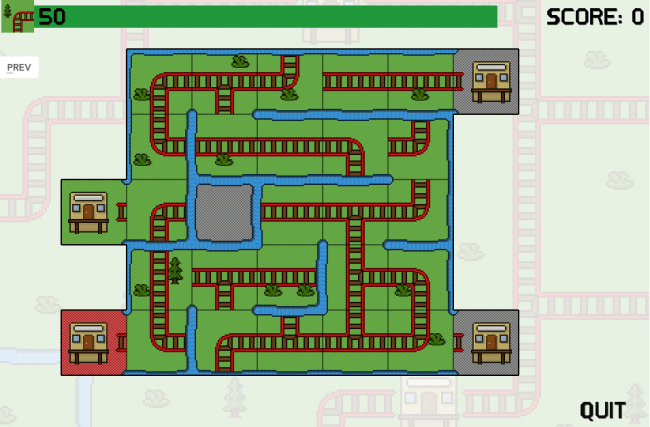- Wondering how to get Monopoly GO! free rolls? Well, you’ve come to the right place. In this guide, we provide you with a bunch of tips and tricks to get some free rolls for the hit new mobile game. We’ll …
Best Roblox Horror Games to Play Right Now – Updated Weekly
By Adele Wilson
Our Best Roblox Horror Games guide features the scariest and most creative experiences to play right now on the platform!The BEST Roblox Games of The Week – Games You Need To Play!
By Sho Roberts
Our feature shares our pick for the Best Roblox Games of the week! With our feature, we guarantee you'll find something new to play!All Grades in Type Soul – Each Race Explained
By Adele Wilson
Our All Grades in Type Soul guide lists every grade in the game for all races, including how to increase your grade quickly!
Last Train to Timbuktu Review
Up until an embarrassingly double-figures age, I was under the impression that Timbuktu wasn’t a real place, thanks to the wonderful Timbuctoo children’s stories series. Thank goodness I’m now aware of its definite realness, or else this review could have exposed my inner silliness to Gamezebo readers everywhere.

You should choo-choo-choose Last Train to Timbuktu
Up until an embarrassingly double-figures age, I was under the impression that Timbuktu wasn’t a real place, thanks to the wonderful Timbuctoo children’s stories series. Thank goodness I’m now aware of its definite realness, or else this review could have exposed my inner silliness to Gamezebo readers everywhere.
Last Train to Timbuktu is a relatively simplistic sliding-tide puzzler based around the idea of creating complete paths for a train to travel along. It’s a lovely little thing, although you most likely won’t put more than an hour or so into it.
Each of Last Train‘s levels involve sliding tiles on a grid up, down, left, or right. By sliding said tiles around, your job is to create a train track that connects one station to the other, allowing the train to make its journey.
Interestingly, no two games of Last Train are the same, as the levels are randomly selected each time you play. There are also special ways to receive extra points, such as connecting blue stations up to the main track, and collecting flowers.
The game is split up into four separate modes. Practice mode is the base mode, allowing you to fiddle around with puzzles without any time or move constraints. Race mode sees you attempting to complete a series of puzzles as quickly as possible, in a bid to beat a car to Timbuktu.
Then you’ve got Time Challenge which, as you’d guess from the name, is all about finishing as many puzzles as you can in a set time limit. Finally, Move Challenge mode gives you a maximum number of moves, and asks you to complete as many puzzles as possible within that limit.
Although the game’s visuals feel rather amateurish, there’s a certain charm to the experience, especially when it comes to the plinky plinky piano that accompanies each move and completion. I noticed graphical issues here and there, but I still found myself warming up to Last Train‘s overall demeanour.
Notably you’ll want to jump into the options menu and ramp up the difficulty if you want to top the highscore tables. This bumps up the size of the puzzles and increases the number of moves that it usually takes on average to complete a puzzle.
Last Train is great for a short while, but it soon becomes apparent that, although the puzzles are randomly selected, there isn’t actually a huge amount of variation in the general layouts. After an hour you’ll most likely have learnt the various moves that the game wants you to make, and you’ll be able to guess each puzzle’s solution just by looking at it.
The game really could have done with online highscores too. As it is there’s not really anything that made me want to continue playing after the first hour, but if I were able to track my progress against people online, this may well have spurred me on.
Last Train to Timbuktu is a cute labor of love, and for the cheap asking price, it’s difficult to believe that anyone could be disappointed with what it offers.

The good

The bad
More articles...
Monopoly GO! Free Rolls – Links For Free Dice
By Glen Fox
Wondering how to get Monopoly GO! free rolls? Well, you’ve come to the right place. In this guide, we provide you with a bunch of tips and tricks to get some free rolls for the hit new mobile game. We’ll …Best Roblox Horror Games to Play Right Now – Updated Weekly
By Adele Wilson
Our Best Roblox Horror Games guide features the scariest and most creative experiences to play right now on the platform!The BEST Roblox Games of The Week – Games You Need To Play!
By Sho Roberts
Our feature shares our pick for the Best Roblox Games of the week! With our feature, we guarantee you'll find something new to play!All Grades in Type Soul – Each Race Explained
By Adele Wilson
Our All Grades in Type Soul guide lists every grade in the game for all races, including how to increase your grade quickly!








 “
“